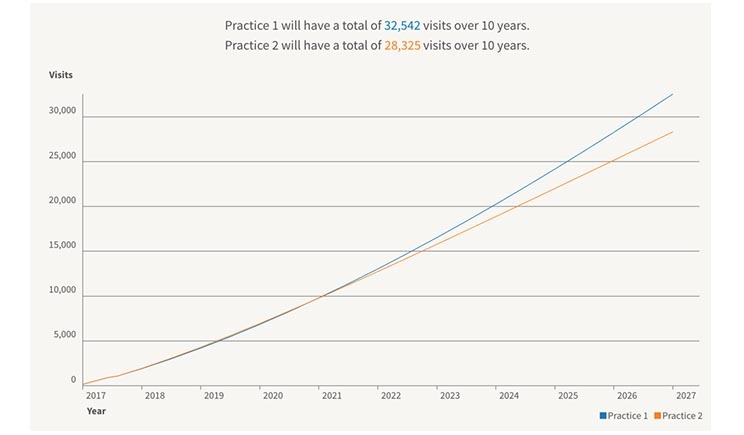
When working to ensure that your practice’s schedule is at capacity, it’s natural to focus on attracting new patients. Though attracting patients is an important facet of growing your practice, in most cases, improving patient retention by pre-appointing your existing patients actually yields a higher return on investment.
A Hypothetical Example
To illustrate why this is the case, we’ll use ValuePenguin Software’s Dental Practice Growth Simulator to compare the impact of attracting new patients versus retaining existing patients. In this example, we’ll compare the performance of 2 hypothetical solo practices: one that focuses on pre-appointing existing patients, and another that focuses on attracting new patients. Hygiene pre-appointment rate, which is the percentage of patients that schedule their next hygiene appointment before leaving your office, is one of the most important key performance indicators for a dental practice to monitor because it greatly impacts the patient retention rate.
We’ll assume that each practice currently sees 150 patients per month and has a 25% recall rate. (For the precise definition of these terms, consult the Methodology section of the Dental Practice Growth Simulator.) We’ll also assume the following:
- Practice 1 has a 93% hygiene pre-appointment rate, which puts it in the top tenth percentile of practices, according to data from Dental Intelligence, and attracts 25 new patients per month.
- Practice 2 has a 75% hygiene pre-appointment rate, which is roughly average, and attracts 50 new patients per month. This practice has a lower pre-appointment rate than the 85% to 90% target that is typically recommended by practice management consultants. However, it acquires twice as many new patients each month compared to Practice 1.
Using the simulator, here’s how many total patient visits we can expect each practice to have over the next 10 years (see the Figure). We can expect Practice 1 to have 32,542 patient visits and Practice 2 to have 28,325 visits. This means that Practice 1 will have about 15% more patient visits than Practice 2, even though Practice 2 was twice as successful at attracting new patients. And, this gap will continue to widen over the years.
Why Does This Happen?
Intuitively, the more patients you currently have, the more important it is to retain them. Otherwise, you will lose patients at a faster rate than you can possibly acquire them. If you consider an extreme scenario in which a practice sees 10,000 patients per year, yet only retains 50%, this means it will lose 5,000 patients during the first year.
It’s difficult to create a marketing strategy that can acquire patients quickly enough to fill this hole. And even if you do acquire new patients, their customer lifetime value will be low, as long as your retention rate remains low. By putting efficient processes in place to effectively pre-appoint a high percentage of your patients, you’ll increase patient retention, which will ultimately increase the customer lifetime value of each new patient that comes to your practice.
“Most practices we see spend thousands of dollars each month and countless hours trying to attract new patients in order to maintain or improve their production and profitability in the practice,” said Weston Lunsford, CEO of Dental Intelligence. “While new patients are important, they are not as important as retaining existing patients. Most practices would far exceed their financial goals if they spent just a few minutes each day on patient retention.”
The good news is that once you have efficient processes in place to pre-appoint patients, it’s significantly easier to retain patients than it is to attract new ones. In general, it’s expensive to acquire new patients. Some studies estimate that it’s at least 5 times more expensive to attract a new customer than it is to retain an existing one.
The Role of New Patients
So, when is it appropriate to focus on attracting new patients? As a general rule of thumb, the more active patients you currently have, the more important it is to focus on retaining them. On the flip side, if your practice is just starting out, and you don’t have a large number of active patients, then it makes more sense to focus on acquiring more patients, and then put efficient processes in place to ensure that you’re retaining them.
As long as your practice has the capacity to offer quality care to additional patients, it’s usually not a bad idea to do what you can to attract new patients. But if you already have a substantial patient base, yet your pre-appointment rate is not quite as high as the industry’s standard recommendation of 85% to 90%, then you’d be better off first improving your pre-appointment rate and then making sure your practice has efficient processes in place to maximize this metric.
Mr. Quinn is a cofounder of Software Pundit, which provides in-depth product reviews and resources to help business owners make well-informed decisions. At ValuePenguin Software, he leverages his analytical background, stemming from his years of experience in the financial services industry, to provide data-driven research that helps dental practices thrive. He can be reached at brian@softwarepundit.com.
Related Articles
Improve Care and Revenue With Patient Relationship Management Technology
6 Biggest Dental Professional Referral Marketing Mistakes
Lackluster Patient Growth? Check Your Dental Message











